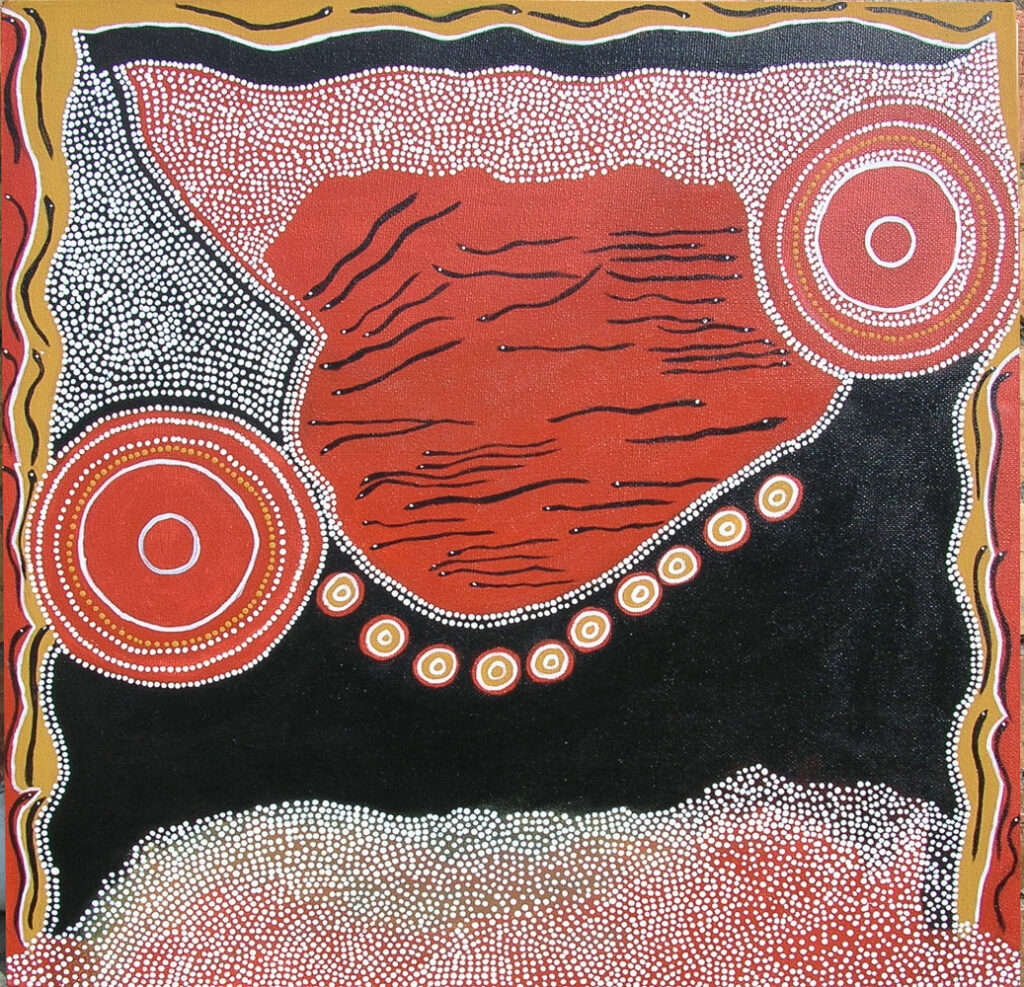
Pat Clarke, The Healing Walk, painting, 2005. This was used for the 2005 festival poster to illustrate the walk, showing Lake Bolac and Warrnambool and the camp sites along the way.
Neil Murray recounts the origins of the Lake Bolac Eel Festival in a walk of reconciliation.
For more than a decade I’d nursed the idea of walking with aboriginal people back into country they’d been removed from. As a small boy, my grandfather had shown me axe heads and grindstones he’d picked up in the paddocks of his farm. He’d explained to me that they were stone tools that belonged to people who’d lived there before. I’d asked him where those people were. He said they’d all gone, but he thought they’d gone down Framlingham way. (Framlingham was an aboriginal reserve established in 1865 near Warrnambool) Even as a boy I sensed something important was missing.
Later in adulthood, my own research confirmed that I had been born and raised in the lands of Tjapwurrung speaking peoples and that any remnant survivors of the frontier wars and dispossession that occurred most likely did end up at Framlingham. But when I was growing up there were no conspicuous aboriginals in my district. The Mornington Island Dance group visited our school in 1974 and I was the first to jump up and volunteer to join a brolga dance with them. Only in hindsight did I realise there were a handful of kids in my high school that were probably of indigenous descent. But no one was owning up to it back then. Little did I know there was an entire community an hour drive to the south.
Since 1993, I had come to know the late uncle Banjo Clarke and his family at Framlingham. Banjo became a source of guidance for me and was one of the influences that lead me to return to the country of my youth. So it was to his family that I first went with the idea of a walk from the mouth of the Hopkins River upstream and inland to Lake Bolac. Effectively we would follow the route young eels would take to reach the lake from the sea. Banjo’s son Lenny Clarke and eldest daughter Patricia, and grandson’s John, Brett and Lee were supportive.
On the 22nd March 2005, the night before the actual walk was to commence I was anxious. Would the indigenous people turn up? I knew what it was, my own 20-year history of drama and chaos in an Aboriginal rock band had rendered me edgy and anticipating bad results.
In 1978, on a quest to be with Aboriginal people, I made my first trip to the Northern Territory and in 1980 I took a job in the western desert settlement of Papunya, driving a store truck for the growing outstation movement. It was an exciting time. Self-determination was in and Anangu were actively engaged in returning to their homelands from whence they’d been removed during the assimilation era. What were once remote camps became the new communities of Mt Leibig, Kintore and Kiwikurra. As well as that I’d met Sammy Tjapanangka Butcher— a gifted, natural musician and together we formed the nucleus of what would become the Warumpi Band. The Warumpi Band—with the late Kumantjayi Burarrawanga on lead vocals—achieved national recognition; but due to the pressures of family and cultural commitments, together with the destructiveness of alcohol abuse—mainstream success would elude us.
Living in the desert, touring with the band, earning the extraordinary depth of meaning by which people were connected to their land, only served to beg more questions. “Where you from? Where’s your family?” I’d been asked repeatedly. I replied I was from Lake Bolac in Western Victoria. Sammy was the first to say to me, “that’s your country, you should sit down there”. I was grateful that they’d confirmed what I’d always felt was true. Your spirit comes from where you were born. I tried to explain southern colonial history to my northern bandmates, in contrast to their desert region, how traditional language and culture had been decimated in Victoria because the squatters were greedy for rich, well-watered country. One effect of being with Anangu people in their country was to increase my comprehension of the enormity of the loss of indigenous knowledge from my own area—so much so—I doubted there would be any point in me ever going back there.
If you sit down in your own country, you will be recognised as belonging to it. You will come to know it. It is all in the land and the stars. Eventually, the land teaches you.
“That’s still your country,” insisted Sammy quietly, “you might pick that language up”, as if it was as easy as finding a stone. What was meant was more fundamental; that if you sit down in your own country, you will be recognised as belonging to it. You will come to know it. It is all in the land and the stars. Eventually, the land teaches you.
Fast forward a couple of decades and here I was, holed up at a friend’s house in Warrnambool with my six-month-old Jack Russel pup named Porji and fellow walk organiser Phil Robertson, whose Toyota Hilux and camp trailer was loaded with our gear and supplies. Phil and I had played for the same footy team and shared the common language of being raised on a soldier settlement farm under the tutelage of hard-working fathers. Phil now worked as an outdoor educator at Latrobe Uni and he brought much needed practical and organizational skill in catering for a bunch of people walking overland. He was the only one who was a professional outdoors person and I chided him about it: “fancy getting paid to go camping”. Finally, I decided to confess my doubts.
“I’m worried no blackfellas will turn up”
“Really. Why wouldn’t they?” Phil gave me serious and considered attention. “You just never know. There’s been a death lately and then maybe. Maybe no one cares for my agenda. People might object. You just never know how people are gonna take it. What right have I got to call a healing walk for anyway? Because I grieve for the frontier murders and mourn the loss of traditional knowledge? They must wonder how can I feel that. They must doubt that I really feel that. I could easily be dismissed as another meddling gubba trying to make up for past injustices”
“Well with all this tucker we’ve got the two of us’ll be living like kings for a month.”
Phil was the right man for the job.
At 6am in pre-dawn darkness we drove to the Hopkins River mouth. I was relieved to see people waiting in the car park, though the pre-arranged dancers had not materialised. The first thing Patricia said was “you took your time getting here, we’ve been waiting nearly half an hour”.
Lenny, resplendent in an orange road workers vest announced; “alright let’s get this show on the road”. After a brief ceremony of exchanging water from Lake Bolac into the river mouth and filling the same jar with water from the estuary to be carried back to Lake Bolac, a dozen or more of us began walking upstream.
Day two and its a sunny afternoon and we’re picking our way across lush green river flats dotted with sleek cud-chewing cattle presided over by grand farm homesteads built on high ground above the flood line. Lenny points out how the best, most accessible positions had been taken up by settlers leaving the mission at Framlingham on rough high ground with a steep descent to the river.
“They stole all the best country mate and give us blacks the scraps,” he said as we came up to an electric fence. We used sticks to prop or hold it down as we stepped over, making jokes about getting zapped. I glanced again at the imposing homestead lording over the river vista. You couldn’t look at it without feeling you were being watched. Suddenly I felt very exposed and vulnerable on the open field of the river flat.
“Yeah hope we don’t get shot,” said Lenny, reading my mind like a bullet. It was delivered with his customary rueful chuckle, but could not disguise the reality of an inherited, latent fear that you could almost taste. How dangerous must it have been for native people trying to move about in the 1840s? Where even on a serene sunny day like this a single shot might ring out from the shutters of a homestead or shepherd’s hut and a tribesman might drop, surprised at the sudden pain shooting through his body and his crimson blood spilling into the green grass.
The next afternoon I was walking through the Fram forest with a song in my head and light rain falling. The only reason there is a forest there now is because it was part of the aboriginal reserve. The surrounding country had long been cleared and cut up into dairy farms. We all paid our respects to Uncle Banjo’s grave on the way through and offered up silent prayers for the old people to give us safe passage. We followed the Hopkins River for five days before diverging up the Salt Creek. Seven of us were from the indigenous community of Framlingham. For the first time in 140 years or so they were walking country that their ancestors knew intimately and following the same pathways as if they were travelling to the annual eel harvest at Lake Bolac. (In pre-settlement times, when the autumn rains overflowed the lake and the eels were induced to migrate to the sea, intertribal gatherings of up to a thousand people would occur at buloke)
When you walk in country, things come to you. Your senses sharpen. Your perception of time and distance adapts to walking pace and you see everything within that parameter. You are alert to detail. It’s not just that you notice particular rocks, soil, tracks, grasses, plants, trees, insects, lizards, birds and animals, but you begin to discern why you see them. What caused them and what relationship they have with something else. In short, everything speaks. Everything has a story. We began to see that scar trees are more than just the evidence of utilitarian objects garnered but are powerful and resonant icons of grace and beauty, meant to be seen. Like a signpost, boundary marker or warning. Or like a poem that can be contemplated for a hundred years.
We began to practise appropriate protocol for entering someone’s camp. On David Allen’s farm, we halted within 400 metres of his homestead and waited for someone to come out and meet us.
At mid-morning on March 31st 2005 we walked in as a group and stood on the southern shore of Lake Bolac. There was no one to meet us, but for ourselves, it was a triumph. Photos were taken, hugs were had. We’d been fed something unique by the land we’d come through and by the dreams we’d had in the places we’d camped. It was like we’d walked through a book. There was a sense that the past wasn’t distant at all and that nothing good is ever lost. It’s all just residing in the shade. If only the old scar trees could talk.
Thus concluded the first Healing Walk. It coincided with the inaugural Lake Bolac Eel festival—inspired by the eel harvest gatherings once held there. The festival, now in its fourth year, is a community-based event, run on an environmental and reconciliation theme. Held in late March, it presents a contemporary music concert, indigenous dance, environmental forum and art show. Each year the healing walk is organised to precede it.
In 2006 we traced the route of the Fiery Creek from where it rises on Mount Buangor before snaking across the plains to empty into Lake Bolac. Elder, Ted Lovett had welcomed and sent us off with a smoking ceremony and an ochre blessing daubed on our faces so that we would have safe passage. He’d instructed us to be observant for anything unusual, odd or out of the ordinary. In the shadow of the Challicum Hills wind farm, we searched in vain for a trace of the outline of a legendary Bunyip reportedly carved into the turf by a local clan who’d speared it in a waterhole after it devoured one of their countrymen. The clan had periodically maintained the ground marking until it was interfered with by settlers and they no longer returned. 2007 saw us cover the section of the Hopkins River between the Salt Creek junction near Hexham and Wickliffe, before walking overland to Lake Bolac. The condition of the once pristine freshwater lake that year was grim. Drying up for the first time in living memory, thousands of eels died. It was a jolt to my senses to witness irrefutable evidence in my own backyard that climate change was here.
In 2008 we were to complete the remaining section of the Hopkins River we hadn’t covered. It had taken the best part of six months to contact and liaise with landholders to obtain the necessary permission to cross their properties. Despite our benign intentions permission was not always granted and on previous walks, we had been forced to make lengthy detours around offended properties who took a dim view of us. (I’d thought—trespass laws notwithstanding—that as long as we avoided private dwellings, and did not interfere with a landholder’s operations, we could just walk through.) But this year, no deviations would be necessary as we enjoyed unanimous landholder support and our spirits were accordingly buoyant. Perhaps we had earned some respect in the district, whatever, it was satisfying to know there was some goodwill working there.
High in the dividing range of Western Victoria, we gathered. We were mixed-gender farmers, educators, architects, musicians, nurses, Catchment Management representatives, students, retirees and the unemployed. Some of us were of indigenous descent. Most of us were of other. We all shared a desire for intimate engagement with the land. The only way to do that was to walk it. We were going to descend the hills and pick up the emerging Hopkins River and follow it downstream for six days. Walking through farmland meant climbing over fences (many electrified), stumbling through tussocks, thistles and stubbles, avoiding or assisting stock and wildlife – if they happened to be cast, or caught in fences or trapped in muddy dams or creeks. But we would enter places that had been seldom visited since the establishment of private holdings. We were out to witness, first hand, the condition of the land, to consider if we were doing everything we could to arrest increasing salinization, declining stream flows, degradation and weed proliferation. To see if there were ways we might contribute to flora and fauna regeneration and ecological repair. We felt our presence, coupled with a deep sense of care and respect for the earth would help. That the land would let us know. It would help in how we listened to the concerns of farmers we met along the way who were trying to balance sustainable rural practice with the need to turn a profit. It would help in how we encountered and sought to preserve the signs of prior indigenous occupation.
From the hills, we split into groups to follow separate watersheds that fed into two main tributaries. I lead my group out along a bare ridge to the north of Langi Ghiran. We investigated an abandoned farmhouse perched on the crown of the hill. It had spectacular 180-degree views. The pine trees on its western side slumped at a permanent lean of 60 degrees from the prevailing gales. All of us immediately felt we wanted to live there if we could. We figured we could hide out from the law or make it into a recording studio. Rick, an earnest, alternative-type architect from Ballarat remarked it was a waste of a good house. Whatever dilapidated dwelling we encountered on the walk Rick would always inspect it thoroughly before declaring it worthy of resurrection and habitation. He envisaged entire communities springing from bluestone ruins.
Descending the slope below the house we struck upon a small dam, perhaps the highest in the catchment. Fifty metres below that was a dead red gum tree. It had grown at high elevation. There were some remnant box trees nearby but no other red gums grew higher. Brett Clarke, a Kirrae-wurrung man, was with me as we drew nearer to the dead tree. Then we saw it. A large beautifully shaped elongated scar on the northern flank of its trunk. On its southern flank was another of similar size and bearing. A marked red gum this high up, had us convinced that this was the headwater of the Hopkins River. They are not called river red gums for nothing. Their entire existence is associated with water. Their unique individuality collectively delineates a watercourse. Their heavy boughs and fingering branches explore the delicate space above waterholes and reed beds. Massive great grandfather specimens on the floodplain hold up the sky.
Brett had grown up around the lower Hopkins River and he’d always wanted to see where the river came from. He would take photos of every scar tree we encountered for the next 6 days.
By the third night, everyone had found his or her niche in camp life. There were those who leant towards construction, so they handled erecting and pegging the huge tarps that we slept under in our swags. Others preferred firewood collection, food preparation, cooking or washing up. We had become a well-drilled, self-supporting family band of 16 or so souls.
On the third morning out, with Porji at my heel, I walked for an hour then I left the river and set out across a barren flood plain to investigate a hill that had curious standing stones and boulders on its summit. I tended to walk quicker than the others and as the ground began to steepen they were still not in sight. I figured they were probably a couple of kilometres back obscured in the timber that clung to the river. Breathing hard, I was bent double as I made the summit and picked my way to the base of a three-metre high stone monolith. I rested with my back against it and gazed out to the north across the flood plains. Langi Ghiran, where we’d started from three days ago, seemed close on the horizon. The river looped neatly around the eastern base of the hill. Secret pools glistened between the red gums and reeds. I wondered what story there would have been to explain the place. Was this rock I leant against a dreamtime ancestor? It was far too prominent and unusual not to have an explanation.
Prior to my ascent, I’d kicked a stone axe with my boot at the base of a red gum at the foot of the hill. I radioed Brett to tell him where to look for it as he came by. I knew that this place was where district clans had met with George Augustus Robinson, their protector in 1841. They’d stamped the ground and declared passionately that the country was theirs. And they’d made their complaints clear to him; ”tell the white men to stop shooting at us”.
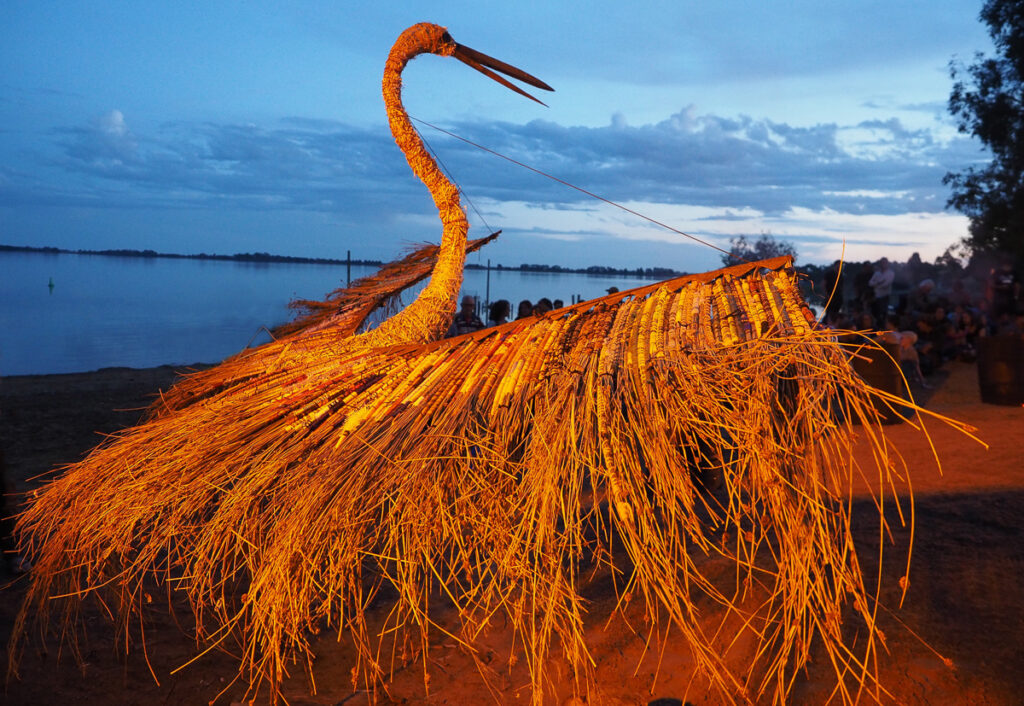
Bronwyn Razem and David Jones, Brolga, created in collaboration with Gunditjimara community and sourced from scrap metal in local farm, 2018
An eagle soared above me. A fox slunk through bracken then trotted off the brow of the hill, its tail floating behind its body like a stiff flame before slipping below the riverbank. Three roos, probably spooked by the walkers were bounding slowly across the flood plain, lifting effortlessly one by one to clear a fence. They propped and looked back in the direction they’d come. Then I saw them too. Hominid shapes, walking upright, emerging from the tree line and starting to come across the plain towards the hill where I waited. From this distance, I couldn’t tell whether they wore clothes or animal skins. I was struck with a primordial recognition of ourselves as human animals sharing the landscape with other creatures. Utterly dependent-like them, on a supply of water, food and air. That despite the plethora of technological gadgetry that cocoons us in our modern world, that is what we still are. The roos were curious too—they don’t see many humans walking now—though somewhere in their species memory they must know their upright gait. Enough to move them into desultory hops, perhaps keeping a safe spear distance.
After exploring the hill, a few of us took a bracing dip in a waterhole downstream. Despite the warm late march day, the chill of the water took my breath away. But I emerged more startled and alive than I had entered.
On our second last day, we were camped on the shore of dry Lake Buninjon. Stretched out a full sixty degrees across the horizon was the Grampians mountain range. All that afternoon of the walk we’d watched a storm brewing up behind its southern end. As the wind got up, a local farmer dropped by in his ute to offer us a shed to shelter in. We declined. Rick and Phil had the tarps set low and taught like an aerodynamic wing. We were confident we’d ride out the storm.
Spectacular lightning forked over the mountains. Brett was trying to photograph it. Just as we got dinner cooked the rain hit like nails. We all sheltered under the tarp, eating rice and vegetables, watching the water pour. The rain soon eased then the sun poked out from under the cloudbank and a magnificent double rainbow appeared on the back of the departing storm. In the northwest, the mountains were now a dark blue-grey, with fingers of white mist like ghosts streaking from its folds. Again the cameras came out. Exposure to such primal elements of weather worked to bond us even more.
Two days later when we arrived at Wickliffe I was feeling an incredible, unexplained love for the group. They were not just my companions, they were like family. Together we’d helped each other, supported each other and shared an intimate dialogue with an evolving river land dynamic over distance, that in turn explored our own inner landscape with each other and ourselves. It may take a few days for the veneer of urban, motorised existence to subside from our systems but eventually, through the simple act of using one’s legs to traverse the ground and the cumulative effect of sleeping outdoors, everyone connects back to the earth in a fundamental way. Participants report a feeling of well being, restorative to mind and body. Each healing walk affirms that just as wildlife needs corridors to roam, so do people. People need to walk in a landscape that is meaningful to them. One of the aims of the Healing Walk is to promote overland walking in empathy with traditional indigenous pathways.
I was on a high from the walk. I felt more alive, stronger and fitter than I would be at any other time of the year. I wanted to keep that feeling. I didn’t want to come down to; emails, bills, responsibilities, taxes, telephone, TV, the Internet. I wanted to stay out there close to something sacred. For a handful of days, we’d held it between ourselves. Felt ourselves connected to all living things. Felt the lineage of all our ancestors back to the first peoples that ever emerged to take a step.

Eel trap woven by Sandra Aitkens from farm baling twine. In 2012 a group of artists joined the healing Walk from Lake Bolac to Warrnambool. They were commissioned to create a work inspired by the walk. Sandra found some blue baling twine on the first morning (Warrnambool Art Gallery in February, 2013).
This was previously published as “A Healing Walk: notes on walking home” by the University of Portland Magazine, Summer 2009. Thanks to Rachel Taylor and Una Allender for assistance with this article. The Lake Bolac Eel Festival – Kuyang Lapakira will resume in 2022.
About Neil Murray

Neil Murray was raised on a farm near Lake Bolac. His ancestors were forced out of Scotland during the highland clearances in 1848. He moved to Papunya in 1980 to assist the outstations movement and became a founding member of the Warumpi Band, pioneers of Aboriginal rock music. He is the composer of the song My Island Home and his books include Sing for Me, Countryman (1993), One Man Tribe (poetry 1999) and Native Born ( lyrics, 2008). He has enjoyed a solo singer-songwriter career since 1989, releasing more than a dozen albums. The latest is Blood & Longing. Visit www.neilmurray.com.au.

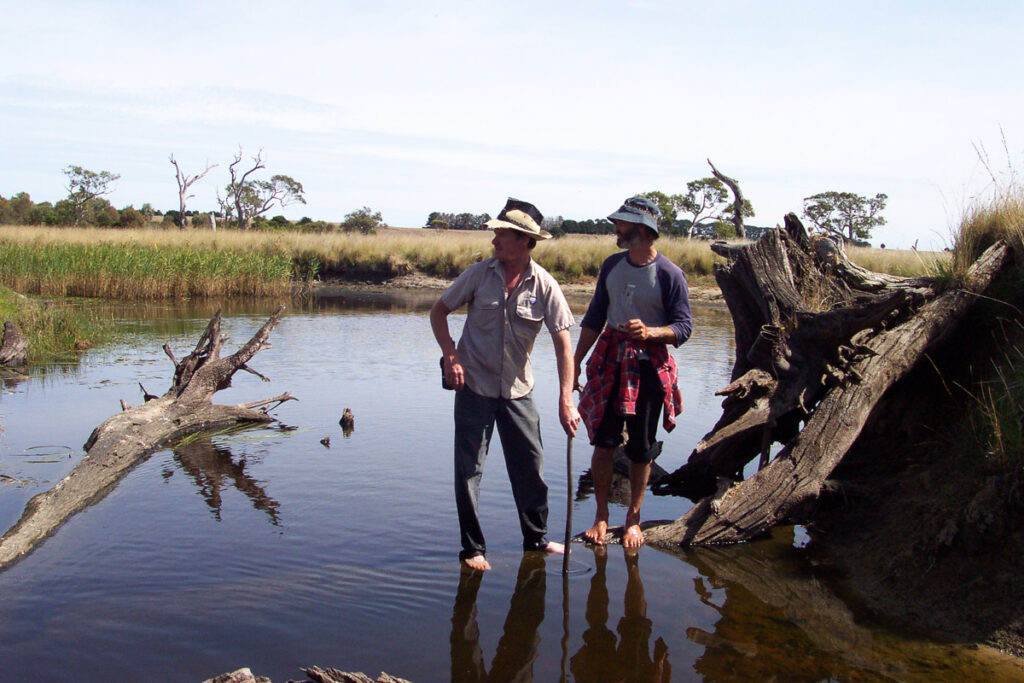

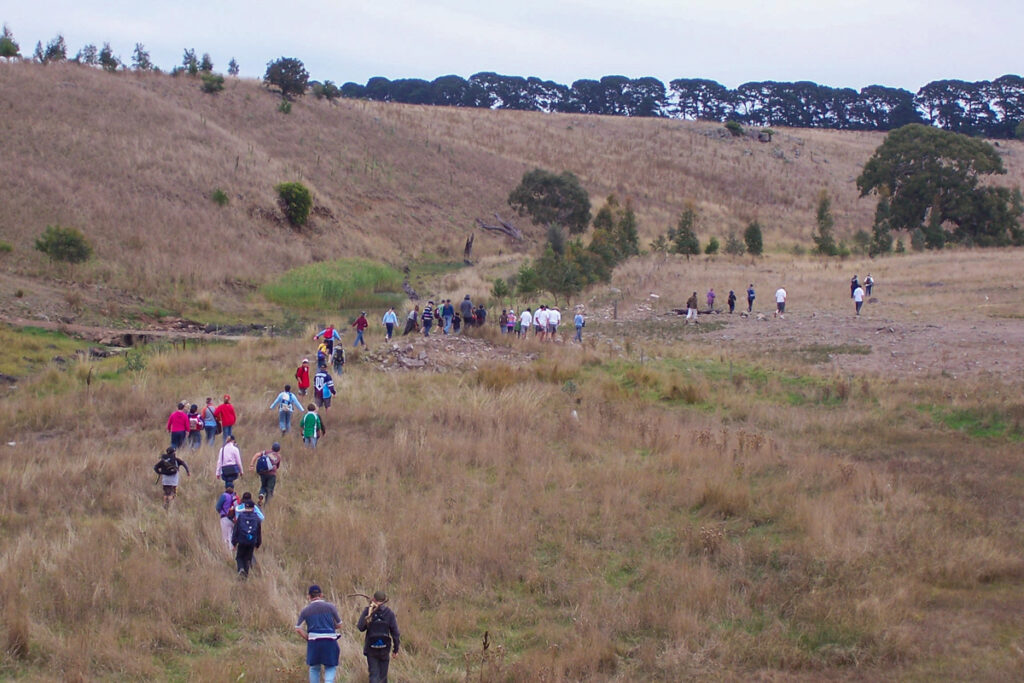

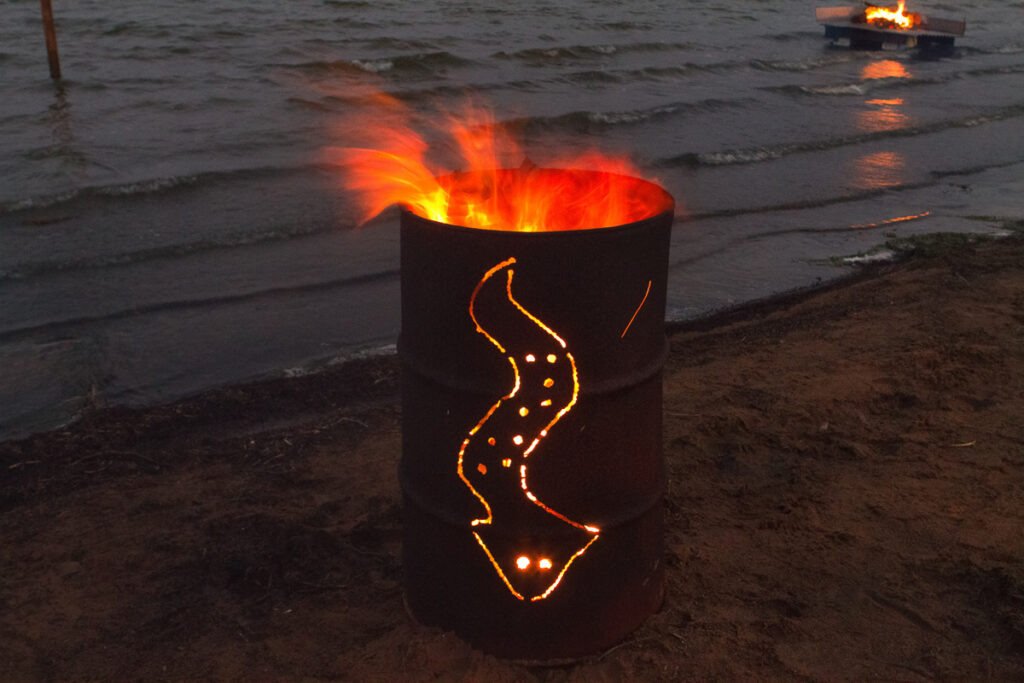

Comments
I enjoyed reading this article very much…
The healing and growing power of walking. Loved reading of these walks.
So sorry to hear of desecration by the moving of stones in this area today.
Thank-you for the article, for doing the walk, for enlivening the land, for persevering, for evoking that place so respectfully. I would like to sit in that country again, may be my country too or close by. Neighbours? I was born, may be found, in Ballarat. One time I was travelling from the east across that country to the west I kept thinking I don’t want to go to Ballarat, it’s cold is all my Mum says about it, ‘we moved away, it was too cold.’ no matter how many times I turned away Ballarat showed up at the next intersection. I went there, I arrived in the dark ‘camped’ that night and the next in the Botanic gardens, under a glamour, by Lake Wendouree, it was curiously welcoming & delightful, something of the corrugated iron in a dreamtime story I was once told. I am a visitor waiting on the edge, hopefully a welcome one, one day, if I am really lucky. Always was, always will be Aboriginal land.
22-23 March 2024! https://www.eelfestival.org.au/